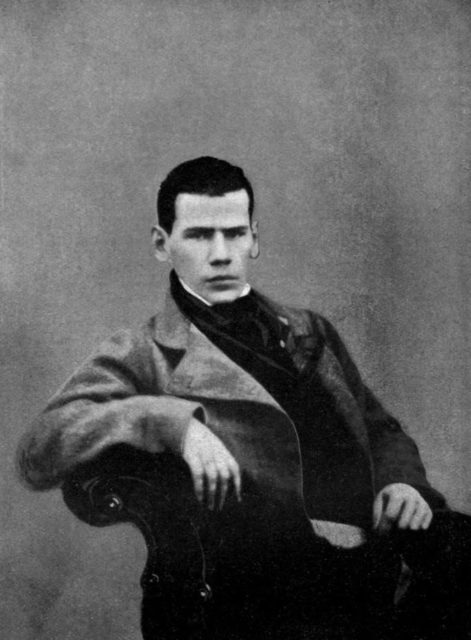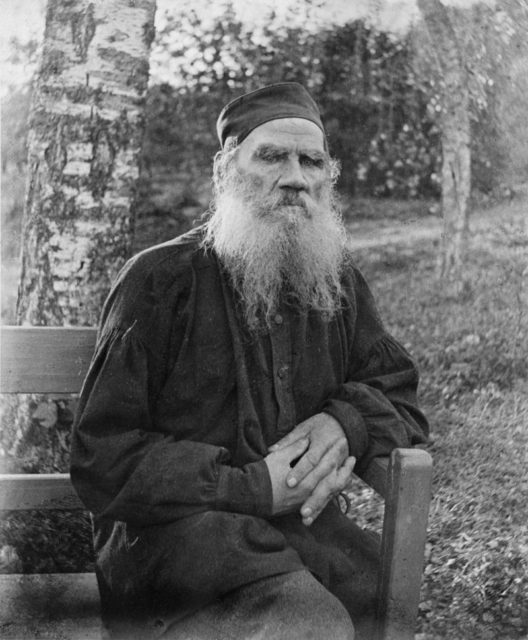Leo Tolstoy is considered to be one of the most important and prolific writers in history due to his two masterpiece novels, War and Peace and Anna Karenina.
Count Lev Nikolayevich Tolstoy was born on 9 September 1828, in Tula Province, Russia, to Count Nikolai Ilyich Tolstoy and Countess Mariya Volkonskaya.
His mother died in 1830 and his father in 1837. Leo and his three brothers were brought up by a cousin and a succession of several aunts.

He was tutored by French and German teachers during his early education and then enrolled at the University of Kazan to study Asian languages in 1843. He was a poor student who preferred having fun to studying. He soon transferred to the law program, but still left the university in 1847 with no degree. He worked on a farm for a while, but again, his partying lifestyle caused him to fail at that as well.
When his brother, Nikolay came home on leave, he persuaded Tolstoy to join the Army, where he fought in the Crimean War in the Ukraine until 1855. While he was in the Army, he wrote his first story called Childhood, in which he recalled the memories of his early life. The story was quickly published in The Contemporary Journal, and Tolstoy was on his way to becoming a writer.
He began writing about his time in the service but put the book on hold until after he had left the Army. In the meantime, he began the second of his autobiographic books, called Boyhood, and a trilogy of his opinions of the Army in Sevastopol Tales.
After his service was complete, Tolstoy returned to Russia. He soon declared himself a revolutionary and moved to Paris in 1857. His partying lifestyle again proved to be his downfall, and he was forced to return to Russia, but not before he had his third autobiographical book, Youth, published in the same year.
In 1862, Tolstoy married Sophia Andreevna Behrs, the daughter of Doctor Andrey Evstafievich Behrs, and soon began work on Yasnaya Polyana. It was after this that Tolstoy began work on his greatest masterpiece, War and Peace, which was historically based on the Napoleonic Wars with vibrant fictional characters. In total, Tolstoy and Sophia had thirteen children, although two died in infancy.

Next was Anna Karenina, which took place in Russia during the war with the Ottomans. The earnings of his books were gradually making Tolstoy a very wealthy author.
Tolstoy was always looking for the meaning of his life and believed he could find salvation within the Russian Orthodox Church. After attending services, he decided all Christian churches were unethical and published a treatise on this belief, The Mediator, in 1883. Because of this, he was kicked out of the Church and was kept under surveillance by the secret police. He decided that Jesus’ Sermon on the Mount was more important than the Bible and was meant to be taken literally. He discussed this in his work, The Kingdom of God Is Within You, which was influential for others who believed non-violence was the answer, including Mohandas Gandhi and the Reverend Martin Luther King, Jr.
Tolstoy’s writing was very prolific in the 1880s and 1890s, producing The Death of Ivan Ilyich, Father Sergius, and Resurrection. He also published several essays on the type of art being produced in Russia and a play called The Living Corpse.

In his later years, Tolstoy fancied himself to be a moral and religious leader, eschewing non-violence as the way to resist evil. He decided to give away all of his money and renounce his aristocratic titles. His wife did not agree with his newfound beliefs, causing problems in their marriage. By this time, Tolstoy was famous and the media was eager to report on his personal problems.
In 1910, to take a break from his marital problems, Tolstoy, his daughter Aleksandra and his doctor, Dushan P. Makovitski, decided to embark on a pilgrimage of self-discovery and left in the middle of the night hoping to elude the press. His advanced age and declining health caught up with Tolstoy, and after only one day of traveling, he collapsed at the train station in Astapovo. He was rushed to the home of the station master and given camphor and morphine. He passed away from pneumonia on November 20, 1910, at the age of 82.
Tolstoy was buried in the forest on his family’s estate of Yasnaya Polyana in Tula Province, Russia. His wife outlived him by nine years and was also buried on the estate after her death in 1919.
